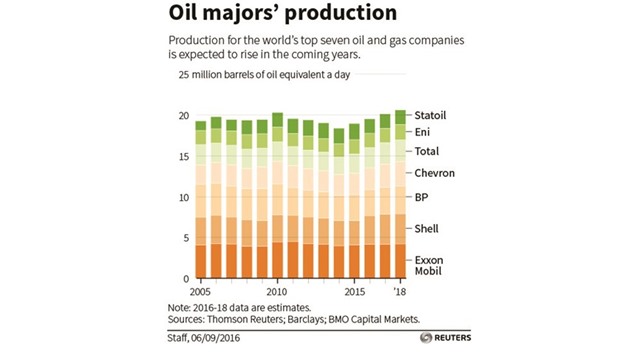The largest oil traders are anticipating little relief to what has become the worst market slump in a generation.
All but one of 15 senior oil traders and executives interviewed last week at the annual Asia-Pacific Petroleum Conference in Singapore expect crude to remain between $40 and $60 a barrel over the next 12 months. Brent crude has traded in that range for the past five months.
Oil and natural gas companies have cut more than 350,000 jobs since crude prices started to fall in 2014 as explorers slashed hundreds of billions of dollars in investment to weather the rout. While crude has climbed from the 12-year lows reached at the start of 2016, a supply glut caused by the US shale boom is pinning prices at half the levels of two years ago.
“The issue is that once prices go up too fast, American drillers start to produce more,” Arzu Azimov, head of Socar Trading, said. “The market will stay in the corridor of $40 to $50, max $55.”
The majority of oil traders said market re-balancing has been pushed back by at least six months from their projections in early 2016 because of higher-than-expected production from Iran and Saudi Arabia, coupled with the resilience of US shale output.
“The oil market isn’t yet balanced,” Saad Rahim, chief economist at oil trading house Trafigura Group said. “The market has yet to start working through millions of barrels of inventories accumulated during the downturn.”
The bearish tone at Asia’s top energy conference reflects scepticism that Opec nations and other producers can agree to cap output and shrink a global glut when they meet for talks later this month in Algiers.
While oil prices have jumped more than 10% since early August amid speculation that Saudi Arabia and Russia can marshal an production freeze, their actions point in a different direction. Riyadh is pumping the most crude on record, while Russian oil output climbed above 11mn bpd for the first time since at least 1991, according to data published on the website of Energy Ministry’s CDU-TEK unit for start of September.
Oil prices are likely to stay around current levels “for the next two years,” said Christoph Ruehl, chief economist at the $800bn Abu Dhabi Investment Authority. Abu Dhabi produces most the oil in the UAE, Opec’s fourth-ranked producer.
“Prices may well be capped around current levels for another year, rather than rising gradually through 2017,” said Amrita Sen, chief oil analyst at consultants Energy Aspects Ltd.
Brent hit a 12-year low of $27.10 a barrel in January. Freezing output would have a limited impact on prices with the biggest producers pumping at close to record levels. Higher prices over the coming months would require production cuts to change supply and demand balances.
“There’s a risk of crying wolf,” David Fyfe, head of market analysis at oil trader Gunvor Group, told the conference in Singapore.
Traders said the risk of a significant decline in prices is limited as the gap between supply and demand narrows. Global oil markets will continue to re-balance this year as a pick-up in demand from refiners absorbs record output from several Gulf producers, the International Energy Agency predicted last month. “In general, we believe we are getting closer to balance,” Eiong Tan, head of crude trading in Asia at BP, said in an interview. “Consumption is catching up with supply.”
Even when the market moves into a deficit, it will have to work through millions of barrels accumulated as inventories since 2014. Keisuke Sadamori, director of energy markets and security at the International Energy Agency, told conference delegates that petroleum stocks haven’t substantially declined yet.
The “huge” stockpile accumulated over the past two years, “will serve as a lid on prices in the near future,” he said.

BIGGEST


